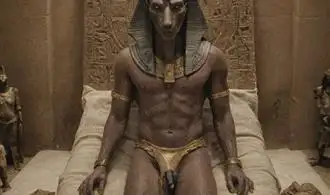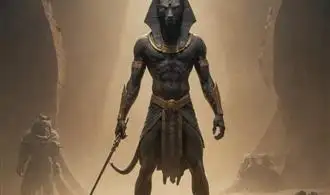
The Origins of Anubis
Anubis, the jackal-headed Egyptian deity, is one of the oldest and most revered gods in the ancient Egyptian pantheon. His origins can be traced back to the predynastic period, where he was associated with the embalming and mummification process. Anubis was believed to be the patron of the necropolis, the sacred city of the dead, and his role in the afterlife was crucial.
The earliest known depictions of Anubis date back to the Naqada I period, around 4000 BCE. These early representations show the god in his jackal-headed form, often guarding the entrance to the underworld or participating in funerary rituals. The jackal was chosen as Anubis' animal form due to its association with the desert, where many burials took place, and its scavenging habits, which were believed to be a part of the mummification process.
As Egyptian civilization evolved, the role and iconography of Anubis expanded. During the Old Kingdom (c. 2686-2181 BCE), Anubis became firmly established as the god of embalming and the protector of the dead. He was often depicted standing guard over the mummified body, ensuring the proper preparation and preservation of the deceased for their journey to the afterlife.
In the Middle Kingdom (c. 2040-1650 BCE), Anubis' prominence continued to grow, and he was increasingly associated with the weighing of the heart ceremony, a crucial step in the Egyptian afterlife. In this ritual, the heart of the deceased was weighed against the feather of truth, and Anubis was responsible for overseeing this process, ensuring the deceased's worthiness to enter the afterlife.
By the New Kingdom (c. 1550-1070 BCE), Anubis had become one of the most important deities in the Egyptian pantheon. His iconography was further developed, and he was often depicted standing beside the embalming table, guiding the mummification process or escorting the deceased to the afterlife. Anubis' role as the god of the dead and the protector of the necropolis was firmly established during this period.
Symbolic Representations of Anubis
Anubis, the jackal-headed Egyptian deity, is a figure of immense significance in ancient Egyptian iconography. His symbolic representations encompass a rich tapestry of meaning, providing insight into the beliefs and practices of this ancient civilization. One of the most prominent aspects of Anubis' iconography is his association with the afterlife and the mummification process.
Anubis was often depicted as a jackal or a man with a jackal head, reflecting his role as the guardian of the dead and the embalming process. The jackal was chosen as Anubis' animal form due to the creature's natural inclination to prowl around cemeteries, suggesting a connection between the jackal and the realm of the dead. Additionally, the jackal's ability to traverse both the physical and spiritual realms made it an appropriate representation of Anubis, who was tasked with guiding the deceased through the afterlife.
The black color of Anubis' skin is another significant aspect of his iconography. Black was associated with the fertile soil of the Nile River, which was essential for the sustenance of life in ancient Egypt. This connection to the earth and the cycle of life and death further reinforced Anubis' role as the protector and guide of the deceased.
Anubis was often depicted holding a crook and a flail, which were symbols of authority and divine power. These implements were associated with the pharaohs, suggesting Anubis' status as a powerful and influential deity. Additionally, Anubis was sometimes shown weighing the heart of the deceased against the feather of Ma'at, the goddess of justice and truth, in the process of judgment and the determination of the soul's fate in the afterlife.
Another important symbolic representation of Anubis is his association with the embalming process. As the god of mummification, Anubis was responsible for the preservation of the deceased's physical form, ensuring the continuation of their existence in the afterlife. This connection is reinforced by the depiction of Anubis kneeling over the mummy, performing the necessary rituals and incantations to prepare the body for its journey to the next life.
In addition to his primary roles, Anubis was also sometimes depicted alongside other deities, such as Osiris and Isis, highlighting his importance within the larger pantheon of ancient Egyptian gods. These associations further strengthen the understanding of Anubis' multifaceted symbolism and his central place in the religious and funerary beliefs of the ancient Egyptians.
Anubis in Funerary Rituals
Anubis, the jackal-headed deity of ancient Egypt, was a pivotal figure in the realm of funerary rituals. As the god associated with embalming, mummification, and the protection of the dead, Anubis played a crucial role in the complex and intricate ceremonies that guided the deceased on their journey to the afterlife.
At the heart of Anubis's role in funerary rituals was his association with the mummification process. As the protector of the dead, Anubis was believed to oversee the entire process of embalming, from the removal of the internal organs to the final wrapping of the body in linen bandages. This sacred task ensured the preservation of the physical form, which was essential for the deceased's transition to the afterlife.
During the mummification process, Anubis was invoked through various rituals and spells, each designed to ensure the protection and sanctity of the deceased. The jackal-headed god was often depicted standing guard over the mummified body, his watchful presence guarding against any potential harm or interference.
Beyond the mummification ritual, Anubis also featured prominently in the funerary rites of ancient Egypt. During the opening of the mouth ceremony, a crucial step in the funerary rituals, Anubis was believed to perform the ritual of "Opening the Mouth," which was thought to restore the deceased's senses and faculties, allowing them to breathe, speak, and partake in the offerings presented to them.
Additionally, Anubis was closely associated with the weighing of the heart ceremony, which determined the fate of the deceased in the afterlife. In this ritual, the heart of the deceased was weighed against the feather of truth, with Anubis overseeing the proceedings and recording the outcome. This judgment was essential for the deceased's successful passage to the realm of the dead and their eventual rebirth in the afterlife.
The iconography of Anubis in funerary rituals was also highly significant. The jackal-headed deity was often depicted in various poses, from standing guard over the mummified body to guiding the deceased through the underworld. These visual representations not only served as powerful symbols of Anubis's role but also carried deep symbolic meaning, conveying the importance of his protective and guiding presence in the funerary rites.
Anubis in Modern Depictions
The ancient Egyptian god Anubis, renowned for his distinctive jackal-like appearance, has captured the imagination of modern audiences across various mediums. While the traditional iconography of Anubis remains prevalent, contemporary artists and media have explored innovative ways to interpret and represent this enigmatic deity.
In the realm of visual arts, Anubis has been a subject of fascination for both classic and avant-garde artists. Paintings and sculptures often depict Anubis in his traditional guise, honoring the timeless elegance of the ancient Egyptian aesthetic. However, some modern artists have taken a more experimental approach, blending Anubis' iconic features with surreal or abstract elements, creating visually striking interpretations that challenge the viewer's perception.
The cinematic world has also embraced the mystique of Anubis, with the god's presence felt in various films and television series. From big-budget blockbusters to independent productions, Anubis has been portrayed as a powerful, mysterious, and sometimes even menacing figure, often serving as a catalyst for the narrative's exploration of themes related to death, the afterlife, and the human condition.
In the world of literature, Anubis has found a prominent place in the works of authors who delve into the rich tapestry of ancient Egyptian mythology. Novels, short stories, and even comic books have woven Anubis into their narratives, using the god's symbolism and mythology to shed light on complex philosophical and spiritual concepts.
The digital age has also seen a surge in the popularity of Anubis-inspired content. From video games that allow players to immerse themselves in the ancient Egyptian world to social media platforms where artists showcase their Anubis-themed creations, the god's presence in the modern digital landscape is undeniable. These contemporary interpretations often blend traditional iconography with contemporary aesthetics, captivating audiences and sparking new perspectives on Anubis and his enduring legacy.















